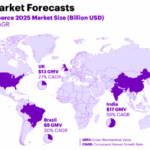In a rapidly evolving digital world, e-commerce is experiencing a significant transformation, and TikTok, the globally recognized short video platform, is emerging as a prominent player in e-commerce scene. With a staggering sevenfold growth in sales over the past year, TikTok is capturing the attention of young, tech-savvy users, combining shopping and entertainment features to create an immersive online experience.
This unprecedented surge in popularity positions TikTok to potentially disrupt the established online shopping landscape.
Many entrepreneurs have experienced substantial growth thanks to TikTok Shop. The platform takes an 8.3% commission on each order, higher than some alternatives, but the value lies in the comprehensive support it provides. Regular workshops and guidance from account managers offer content creation tips and promotional strategies.
TikTok Shop’s rapid ascent is a testament to changing trends in the e-commerce market. Young buyers, seeking genuine connections with sellers, are driving this transformation. Users, who spend an average of three hours daily on social media, find TikTok’s scrolling interface a convenient way to explore products and make informed purchase decisions.
This digital shift is evident in TikTok Shop’s impressive growth figures. The platform’s estimated gross merchandise value (GMV) skyrocketed from $600 million in 2021 to a remarkable $4.4 billion in 2022, according to consultancy Momentum Works. Remarkably, one in four of TikTok’s 325 million monthly users have made purchases through TikTok Shop.
TikTok Shop’s success story spans across different markets. In Vietnam, the platform secured the second spot in the e-commerce market for the first time with a 20% share in the April-June quarter, surpassing even established players like Lazada.
While TikTok’s influence is undeniable, it’s essential to recognize its unique strengths and potential limitations. The platform predominantly caters to smaller orders from younger users, thriving in categories like fashion, beauty, and personal care. However, the need for diversification into other sectors, such as electronics, is evident.
As TikTok shapes the future of e-commerce, industry players are experiencing a year of adjustment. Established platforms are making strategic changes, aiming to maintain profitability in the face of increasing competition. TikTok’s commitment to investing in the region, combined with its appeal to a younger demographic, positions it as a potent challenger to established players.
The digital revolution continues to unfold, driven by platforms like TikTok that are reshaping how people shop and connect with brands. As world embraces this digital transformation, businesses need to adapt to evolving trends and harness the potential that platforms like TikTok offer to redefine the e-commerce landscape.










